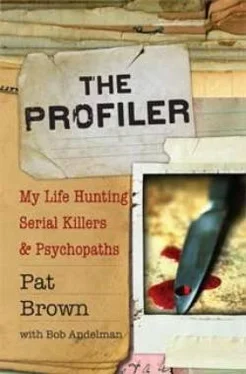So the attacks on Young and Davis could have been perpetrated by him, too. They reflect similar, though escalating, anger and violence. Both the Lisa Young murder and the assault on Vicki Davis showed premeditation, some level of skill controlling the victim, and a violent rage against women. Although I could say there were elements of sadism present, the purpose of the assaults appeared to stem more from anger.
The offender in the Young and Davis crimes brought a knife with him but used materials present at the scene for the binding of the women. He planned part of the crimes but not all of them. However, it should be noted that the offender exuded a good amount of confidence and may have felt no need to bring items he knew would be readily available and less traceable.
Both crimes showed evidence of overkill. Much more violence was done to the women than was necessary to kill them. Vicki by all rights should have been dead, and the assault on her showed an uneven temper. The offender was calm when he was in control and became enraged when he lost control.
An experienced offender committed the crime against Vicki. The man who killed Lisa also showed some level of experience, but not quite as much as in Vicki’s assault. Were these two different offenders or did the same man commit both crimes, Lisa’s and then Vicki’s, showing more capability in the later crime once he acquired more experience? The calm manner in which he assaulted Davis without being terribly hurried showed practice. He took care to not leave evidence and he even commented to Davis that he had “seen it all before.” He put effort into restraining her and controlling the crime scene. Therefore, I thought it was of the utmost importance to look for unsolved rapes and homicides that occurred prior to 1995.
My investigation revealed that Painter was a homebody, and it seems more than coincidental that both the Young and Davis crimes were committed within a couple miles of his residence or the residence of someone he was visiting. I also looked at other crimes that occurred near his previous addresses and places of employment.
I concluded that earlier murders in these areas that did not include binding and knife wounds should not be ruled out as possibly being connected to Painter. Often, earlier crimes of the perpetrator are less complicated and take less time. The perpetrator’s choice of weapons can change due to acquired preferences or availability.
While we may think that the place where a body has been dumped is significant, in fact, most offenders dump a body where it is convenient rather than for some emotional reason. Some pick places where they feel the evidence will be eliminated. For example, a stream could be chosen because it will wash away DNA and fibers or simply because it was available. Perhaps the offender prefers dumping the body in a stream, but there are none nearby, so he instead chooses a field. Most of the time, the dumping of the body is done in the most expedient way. If, however, closer locations are ignored, then there may be a specific reason for a particular dumping location. Sometimes the offender remembers a place nearby where he had a picnic and thinks, “Hey, that place had some nice woods!”
My profile of the perpetrator is someone who liked to be in control. He seemed to savor the moment. It was my feeling that any crime committed by this individual would take a reasonable amount of time. He would not be the sort of anger-retaliatory killer who was in and out of the scene in a matter of minutes. He had some aspect of a power rapist in that he spent time talking to his victim. A power rapist likes to ask his victims about their sexual experiences or how well he is performing. Sometimes he will verbally threaten the victim-he enjoys humiliating her and watching her squirm. He would have liked to see the fear in the face of the woman and he would enjoy the act of killing. However, he would not exhibit the length of time used by a sexual sadist who meticulously planned the killing and torturing of a female for an extended length of time. He would not need to bring the woman to a fixed location nor would he need to bring much more than a knife along for the job-if anything at all.
I believed the perpetrator picked victims he could easily control. He would be unlikely to choose victims from a level of society above him; women who were highly educated or wealthy, for example, would make him feel inferior. He would operate where he felt comfortable. Although neither Young nor Davis was involved in prostitution, I would not discount the possibility that the perpetrator might choose victims who were. Even if he was not the type to use such services, availability is often the reason certain victims are chosen.
Certainly the case against Painter should have gone forward. The grand jury indicted him, and it is a travesty of the criminal justice system that the case was dismissed. Last I heard he was driving a tow truck; isn’t that great news for any woman who calls for help?
I DON’T KNOW if Painter was the attacker, but there was quite a bit of circumstantial evidence linking him to both Lisa’s murder and Vicki’s attack.
That wasn’t the half of it.
When Painter was being interviewed by a detective about Lisa’s murder, he suddenly blurted out, “Oh, by the way, tell Tracie Andrews I’m sorry about Sarah.”
When I heard that, my jaw dropped.
The Sarah Andrews case? What the hell?
Sarah Andrews’s parents lived in the same state as Painter, but Sarah Andrews had died 2,000 miles away and ten years earlier. How would Harold Painter know anything about Sarah Andrews? Why did he say, “I’m sorry about Sarah”?
It turned out that he knew Tracie Andrews, Sarah’s mother, and he knew her very well. She was the longtime best friend of Painter’s ex-wife, and the two of them had stayed in Tracie Andrews’s house when she lived on the very road where Lisa Young’s body was dumped. It was an incredible coincidence-if it was one. But despite all the circumstantial evidence-the car, the boxer dogs, and the bizarre-as-all-get-out connection to Sarah Andrews-Painter was never arrested for the Lisa Young murder and was never brought back in for the attempted homicide of Vicki Davis. The police were still convinced that he attacked Vicki, even though the DNA on the cigarette found at the scene in the living room didn’t match him or Vicki. I agreed with them; something seemed bogus about the DNA testing because everything else pointed toward Painter, and when I called and left a message for the FBI lab technician she called back and angrily told me how great a job she had done. I thought that the fact I got a call back was strange enough in itself (because I had no official capacity in the case and I wasn’t a journalist), but the technician was working overtime to say she hadn’t erred. Eventually, I caught up to the original detective on the Young case in the summer of 2000 and had a nice conversation with him while he worked his part-time job guarding a liquor store.
“He killed Lisa Young and attacked [Vicki Davis]. I never doubted that.”
But, unfortunately, no court ever proved he was guilty in either case.
And did Painter also go out west and kill Sarah Andrews?
I took the information and sent it to the present detective on Sarah’s case, including pictures of Painter’s smiling face and his dental work. If it wasn’t the bouncer or the cross-dresser, the two top suspects that I came up with in that crime, could it be Harold Painter?
Sarah was sexually assaulted with an object, and it is curious that the Davis attack, with which Painter was initially charged, showed anger and rage, though not penetration by him. Perhaps in both cases the perpetrator did not commit rape because he could not perform the act to his satisfaction with his own penis.
Читать дальше












